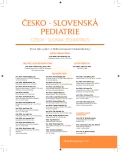Neonatal hemochromatosis associated with renal tubular dysgenesis
Authors:
M. Navratilova 1; E. Šimáková 2; M. Podholová 3; P. Eliáš 4; P. Dědek 1; Z. Kokštein 1; J. Malý 1
Authors‘ workplace:
Dětská klinika FN a LF UK, Hradec Královépřednosta prof. MUDr. M. Bayer, CSc.
1; Fingerlandův ústav patologie FN a LF UK, Hradec Královépřednosta prof. MUDr. A. Ryška, Ph. D.
2; Porodnická a gynekologická klinika FN a LF UK, Hradec Královépřednosta doc. MUDr. J. Špaček, Ph. D.
3; Radiologická klinika FN a LF UK, Hradec Královépřednosta prof. MUDr. A. Krajina, CSc.
4
Published in:
Čes-slov Pediat 2014; 69 (6): 342-349.
Category:
Case Report
Overview
Neonatal hemochromatosis (NH) is a clinical syndrome consisting of severe liver disease accompanied by pathologic siderosis in various extrahepatic tissues. Gestational alloimmune liver disease (GALD) has been established as the cause of fetal liver injury resulting in nearly all cases of NH. The presenting findings of NH are fetal demise during late 2nd and 3rd trimester or, after delivery, signs of liver failure and typically multiple organ dysfunction syndrome with high mortality. Renal tubular dysgenesis (RTD) represents a developmental disorder of fetal kidneys differentiation as a consequence of angiotensinogen deficiency because of evolving fetal liver injury. Oligohydramnion, congenital oligoanuria and refractory hypotension are the leading symptoms of RTD. The coincidence between RTD and NH is well known as the most common renal pathology seen in NH. GALD can be prevented by repetitive intravenous immunoglobulin application during the next pregnancy, starting usually between 14th to 16th postmenstrual weeks.
The authors present a case of GALD manifested as severe neonatal hemochromatosis and renal tubular dysgenesis followed by successful treatment of the mother in the next pregnancy resulting in delivery of the healthy offspring.
Key words:
neonatal hemochromatosis, liver failure, extrahepatic siderosis, gestational alloimmune liver disease, renal tubular dysgenesis, anuria, hypotension, intravenous immunoglobulin
Sources
1. Whitington PF. Neonatal hemochromatosis: A congenital alloimmune hepatitis. Semin Liver Dis 2007; 27: 243–250.
2. Magner M, Ješina P, Klement P. Význam časné diagnostiky dědičných metabolických poruch s manifestací v novorozeneckém věku. Čes-slov Pediat 2013; 68 (1): 3–11.
3. Murray KF, Kowdley KV. Neonatal hemochromatosis. Pediatrics 2001; 108: 960–964.
4. Whitington PF, Kelly S. Outcome of pregnancies at risk for neonatal hemochromatosis is improved by treatment with high-dose intravenous immunoglobulin. Pediatrics 2008; 121 (6): e1615–e1621.
5. Hanchard NA, Shchelochkov OA, Angshumoy R, et al. Deoxyguanosine kinase deficiency presenting as neonatal hemochromatosis. Mol Genet Metab 2011; 103: 262–267.
6. Elleder M, Chlumská A, Hadravská Š, et al. Neonatal (perinatal) hemochromatosis. Čes-slov Patol 2001; 37 (4): 146–153.
7. Bonilla SF, Melin-Aldana H, Whitington PF. Relationship of proximal renal tubular dysgenesis and fetal liver injury in neonatal hemochromatosis. Pediatr Res 2010; 67 (2): 188–193.
8. Bale PM, Kan AE, Dorney SF. Renal proximal tubular dysgenesis associated with severe neonatal hemosiderotic liver disease. Pediatr Pathol 1994; 14 (3): 479–489.
9. Morris S, Akima S, Dahlstrom JE, et al. Renal tubular dysgenesis and neonatal hemochromatosis without pulmonary hypoplasia. Pediatr Nephrol 2004; 19: 341–344.
10. Johal JS, Thorp JW, Oyer CE. Neonatal hemochromatosis, renal tubular dysgenesis, and hypocalvaria in a neonate. Pediatr Dev Pathol 1998; 1: 433–437.
11. Uematsu M, Sakamoto O, Obuta T, et al. A further case of renal tubular dysgenesis surviving the neonatal period. Eur J Pediatr 2009; 168: 207–209.
12. Rand EB, Karpen SJ, Kelly S, et al. Treatment of neonatal hemochromatosis with exchange transfusion and intravenous immunoglobulin. J Pediatr 2009; 155: 566–571.
13. Rennie JM, Roberton NRC (eds). Textbook of Neonatology. 3rd ed. Edinburgh: Churchill Livingstone, 1999: 1409.
14. Feldman AG, Whitington PF. Neonatal hemochromatosis. J Clin Exp Hepatol 2013; 3: 313–320.
15. Schneider BL, Stechell KD, Whitington PF, et al. Delta 4-3-oxosteroid 5 beta-reductase deficiency causing neonatal liver failure and hemochromatosis. J Pediatr 1994; 124 (2): 234–238.
16. Schreiber R, Gubler M-C, Gribouval O, et al. Inherited renal tubular dysgenesis may not be universally fatal. Pediatr Nephrol 2010; 25: 2531–2534.
Labels
Neonatology Paediatrics General practitioner for children and adolescentsArticle was published in
Czech-Slovak Pediatrics

2014 Issue 6
Most read in this issue
- Dextromethorphan in the hands of a teenager – cheap and legal ticket on a „trip“
- Neonatal hemochromatosis associated with renal tubular dysgenesis
-
Onychomadesis po onemocnění ruka-noha-ústa
(hand-foot-mouth disease) - Refeeding syndrome in childhood
